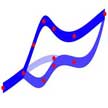
A major challenge for nanophotonics engineers is the wide range of optical responses that metamaterials and other nanoplasmonic structures can generate. In the past few years, machine learning has emerged as a powerful tool for sifting through this vast universe of possible design parameters to aid the design of nanophotonic devices tailored for specific applications. A novel approach uses a type of neural network called a mixture density network to solve the non-uniqueness problem of machine learning algorithms, while also improving accuracy.
